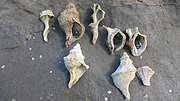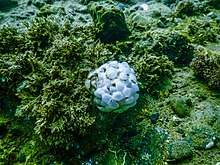Penion sulcatus
Penion sulcatus is a species of medium-to-large predatory marine snail or whelk, commonly called the northern siphon whelk or kākara nui in Māori, belonging to the true whelk family Buccinidae.
| Penion sulcatus | |
|---|---|
| Dorsal view of a shell of Penion sulcatus | |
| Scientific classification | |
| Kingdom: | |
| Phylum: | |
| Class: | |
| (unranked): | |
| Superfamily: | |
| Family: | |
| Genus: | |
| Species: | P. sulcatus |
| Binomial name | |
| Penion sulcatus (Lamarck, 1816) | |
| Synonyms | |
|
Fusus sulcatus Lamarck, 1816 | |
Description
Penion sulcatus is a medium-to-large species of Penion siphon whelk.[1][2] Shells are highly variable in sculpture and colouration, but shells are often dark with a white aperture.[3]
_-_Buccinidae_-_Mollusc_shell.jpeg) A modern, beach worn shell
A modern, beach worn shell_(AM_MA71144-1).jpg)
_(AM_MA72164-1).jpg)
_(AM_MA72198-1).jpg)
 Shells fragments washed ashore at Hobbs Bay, Whangaparaoa
Shells fragments washed ashore at Hobbs Bay, Whangaparaoa
Distribution
Penion sulcatus is endemic to New Zealand.[1][2][4] The species is found of the entire North Island and northern South Island coasts.[2][4] The species has an abundant fossil record in the North Island of New Zealand.[5]
P. sulcatus is benthic and is common on soft-sediments on the continental shelf [6] or within the subtidal rocky shore environment.[3][2]
Ecology

Penion sulcatus is a carnivore and is known to feed on mussels and Dosina zelandica zelandica.[3]
Human use
Shells found in middens of historic Māori settlements indicate that P. sulcatus may have been intentionally foraged as a food-source.[7][8]
References
- Powell A. W. B., New Zealand Mollusca, William Collins Publishers Ltd, Auckland, New Zealand 1979 ISBN 0-00-216906-1
- Vaux, Felix; Crampton, James S.; Marshall, Bruce A.; Trewick, Steven A.; Morgan-Richards, Mary (2017). "Geometric morphometric analysis reveals that the shells of male and female siphon whelks Penion chathamensis are the same size and shape". Molluscan Research. 37 (3): 194–201. doi:10.1080/13235818.2017.1279474.
- Willan, R.C., de C. Cook, S., Spencer, H.G., Creese, R.G., O’Shea, S., Jackson, G.D. Phylum Mollusca. In: de C. Cook, S.C. (eds.), New Zealand Coastal Marine Invertebrates 1, 406 – 407. Canterbury University Press, Christchurch, New Zealand ISBN 978-1877257-60-5
- Vaux, Felix; Hills, Simon F.K.; Marshall, Bruce A.; Trewick, Steven A.; Morgan-Richards, Mary (2017). "A phylogeny of Southern Hemisphere whelks (Gastropoda: Buccinulidae) and concordance with the fossil record". Molecular Phylogenetics and Evolution. 114 (2017): 367–381. doi:10.1016/j.ympev.2017.06.018. PMID 28669812.
- Beu, Alan G.; Maxwell, P.A. (1990). Cenozoic Mollusca of New Zealand. New Zealand Geological Survey Bulletin. 58. Lower Hutt, New Zealand: New Zealand Department of Scientific and Industrial Research. ISSN 0114-2283.
- Dell, R.K.. 1962. New Zealand Marine Provinces - do they exist? Tuatara, 10: 43 - 52. Online Copy courtesy of New Zealand Electronic Text Collection
- Green, R.C.; Pullar, W.A. (1960). "Excavations at Orongo Bay, Gisborne". The Journal of the Polynesian Society. 69 (4): 332–353.
- Allen, Melinda S. (2012). "Molluscan foraging efficiency and patterns of mobility amongst foraging agriculturalists: a case study from northern New Zealand". Journal of Archaeological Science. 39 (2012): 295–307. doi:10.1016/j.jas.2011.09.013.
External links
- Museum of New Zealand Te Papa Tongarewa, Taxon: Penion sulcatus Lamarck, 1816 (Species)
- Revised descriptions of New Zealand Cenozoic Mollusca from Beu and Maxwell (1990): Penion sulcatus (Lamarck, 1816)
- Massey University NZ Fauna Scanned 3D model of Penion sulcatus
- Natural History Museum Rotterdam - Mollusca - Gastropoda - Buccinidae